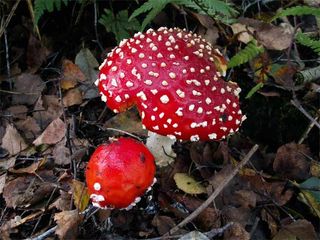6 (Or So) Ways Fungi Can Help Humanity
The Promise of Fungi

Not only are fungi integral to life on the planet as we know it, these organisms can help humanity tackle some particularly daunting problems, mycologist Paul Stamets writes in his book, Mycelium Running: How Mushrooms Can Help Save the World (Ten Speed Press, 2005). Not only can they offer us new pharmaceuticals, help clean up pollutants and restore forests, fungi are just plain amazing, according to Stamets, who outlines how in his book and in talks.
Related: 'Magic' mushrooms in royal garden: What is fly agaric?
Nature's Cleaning Crew

Fungi are decomposers, so they specialize in digesting things. Some are equipped with enzymes that can break down particularly recalcitrant compounds in wood. Since petroleum products are chemically similar, some fungi, such as oyster mushrooms, have shown promise cleaning up sites contaminated by oil, diesel and other petrochemical spills, mycologist Paul Stamets writes in his book Mycelium Running (Ten Speed Press, 2005). Fungi can also break down other contaminants, filter microbes out of water, and concentrate heavy metals in their mushrooms, he writes.
Fungal Healers

Like humans, fungi must fight off bacterial attacks, and they've proven skilled at creating chemical weapons against the microbes. Perhaps the most famous of these harnessed by medicine is pencillin, an antibiotic based on a compound produced by Penicillium molds. Stamets believes fungi have plenty more to offer. In particular, he sees potential in a rare bracket fungus, agarikon.
Restore Forests

Forests would not exist without fungi. Many plants, especially trees, have fungi called mycorrhizae living in and on their roots. These fungi can help the plant absorb nutrients from the soil. In addition to helping trees grow, fungi can also be employed to restore habitat, as well as reduce forest fires and erosion, according to Stamets.
Fighting Insects

Fungi offer natural alternatives to man-made pesticides, which sometimes harm things they aren't intended to. Indeed, fungi have come up with some elaborate ways to kill their targets. One tropical parasitic fungus turns its ant victims into zombies, forcing them to wander in search of a leaf upon which to bite down before dying. A spore-releasing stock then sprouts from the ant's head.
Good for the Ground

Fungi break down rock and decompose plant material, making soils. The fine fibers that make up a fungi, its mycelium, form networks that holds soil together, allowing it to resist erosion, as well as aerating it. By not turning over the soil, or tilling, farmers leave the fungi alone to do their work and so reduce erosion and the need for fertilizer, he writes.
Fungal ETs?

If life exists on other planets, fungi are likely among it, he writes. And recent research indicates some fungi can use ionizing radiation to grow, not unlike plants use sunlight to perform photosynthesis. What's more, by landing the rovers on Mars, NASA may have brought Earthly microbes to another planet, seeding it with terrestrial life. "Spores have no borders," he writes. Maybe this doesn't help us solve a problem, but it is pretty cool.
Sign up for the Live Science daily newsletter now
Get the world’s most fascinating discoveries delivered straight to your inbox.

